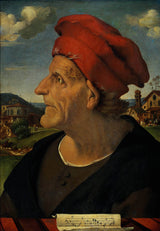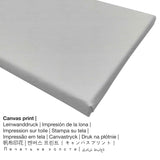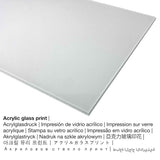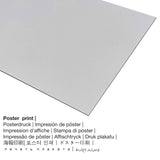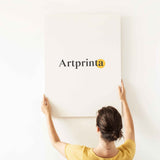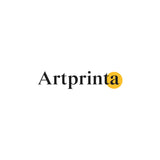Piero di Cosimo, 1482 - Eserese nke Francesco Giamberti (1405-c.1482), Nna Giuliano da Sangallo - ọmarịcha nka nka.
Ụtụ gụnyere. Mbupu gbakọrọ na ndenye ọpụpụ.
Ihe ndị a na-ahọrọ
Nchịkọta nhọrọ ngwaahịa na-enye gị ohere ịhọrọ ngwa na nha nke nhọrọ gị. Nhọrọ ndị a dị maka n'otu n'otu:
- Mbipụta iko acrylic (nke nwere ezigbo mkpuchi iko): An print on acrylic glass, which is sometimes labelled as a print on plexiglass, makes the original work of art into great home décor and forms a distinct alternative to aluminium and canvas prints. With an acrylic glass art print sharp contrasts and minor painting details become more recognizeable because of the fine tonal gradation.
- Mbipụta akwụkwọ mmado (ihe kwaaji): The poster is a UV printed flat canvas paper with a fine texture on the surface. A poster print is excellently suited for putting the art replica in a customized frame. Please bear in mind, that depending on the absolute size of the poster print we add a white margin of something between 2 - 6cm round about the print, which facilitates the framing with a custom frame.
- Mbipụta kwaaji: A canvas direct print is a printed canvas stretched on a wooden stretcher. A canvas produces a exclusive impression of three-dimensionality. How do I hang a canvas on the wall? A canvas print has the advantage of being low in weight, which implies that it is quite simple to hang the Canvas print without the use of extra wall-mounts. Hence, canvas prints are suitable for any type of wall.
- Mbipụta aluminom (aluminium dibbond): This is a metal print manufactured on aluminium dibond with a true effect of depth. A direct Direct Print on Aluminum Dibond is your best introduction to fine art reproductions with aluminum. The colors are luminous in the highest definition, the details are clear and crisp, and you can notice a matte appearance of the print. This print on Aluminum Dibond is the most popular entry-level product and is an extremely sophisticated way to display fine art prints, because it puts all of the viewer’s focus on the image.
Ederede iwu dị mkpa: We try whatever we can to describe our art products with as many details as possible and to demonstrate them visually on the different product detail pages. Nonetheless, the colors of the print materials, as well as the print result can vary slightly from the image on your monitor. Depending on the screen settings and the quality of the surface, color pigments may not be printed as realistically as the digital version shown here. Considering that all the are processed and printed by hand, there might as well be minor discrepancies in the motif's exact position and the size.
Ozi nka sitere na ihe ngosi nka (© Nwebiisinka - nke Mauritshuis - Maurithuis)
Francesco da San Gallo, Florence, rue 1567; King James II, London, rue 1688; King-Stadholder William III, London, mgbe 1688 gasịrị; Het Loo Palace, Apeldoorn; Prince William V, The Hague, ruo 1795; ndị France weghaara, bufee ya na Museum Central des Arts/Musée Napoléon (Musée du Louvre), Paris, 1795-1815; Ụlọ ihe nkiri Royal, nke dị na Prince William V Gallery, The Hague, 1816; bufere na Mauritshuis, 1822; na ogologo oge mbinye na Rijksmuseum, Amsterdam (inv. no. SK-C-1367), kemgbe 1948
Nchịkọta nke oyiri
Posthumous Portrait of Francesco Giamberti (1405-c.1482), Father of Giuliano da Sangallo is an artpiece created by the early renaissance Italian onye na-ese ihe Piero di Cosimo. Ihe izizi tụrụ nha: ịdị elu: 47,5 cm obosara: 33,7 cm | elu: 18,7 n'obosara: 13,3 inch. Mmanụ na panel was used by the European painter as the medium of the artwork. Nowadays, this artwork is included in the Mauritshuis's digital art collection, which the Mauritshuis is home to the best artworks of Dutch painting of the seventeenth century. The ngalaba ọha masterpiece na-gụnyere na nkwanye ùgwù nke Maurithuis, Hague. Creditline of the artwork: Francesco da San Gallo, Florence, until 1567; King James II, London, until 1688; King-Stadholder William III, London, after 1688; Het Loo Palace, Apeldoorn; Prince William V, The Hague, until 1795; confiscated by the French, transferred to the Muséum Central des Arts/Musée Napoléon (Musée du Louvre), Paris, 1795-1815; Royal Picture Gallery, housed in the Prince William V Gallery, The Hague, 1816; transferred to the Mauritshuis, 1822; on long-term loan to the Rijksmuseum, Amsterdam (inv. no. SK-C-1367), since 1948. The alignment of the digital reproduction is in Eserese format ma nwee oke nke 1: 1.4, nke pụtara na ogologo bụ 29% mkpụmkpụ karịa obosara. The painter Piero di Cosimo was an artist from Italy, whose art style was primarily Early Renaissance. The Early Renaissance painter was born in 1461 in Florence, Firenze province, Tuscany, Italy and deceased at the age of 60 in the year 1521 in Florence, Firenze province, Tuscany, Italy.
Nkọwa ahaziri nke mpempe nka
| Aha nka: | "Posthumous Portrait of Francesco Giamberti (1405-c.1482), Father of Giuliano da Sangallo" |
| Nhazi nka nka: | sere |
| Nhazi nka: | nka ochie |
| oge: | 15th narị afọ |
| Afọ nka: | 1482 |
| Afọ nka: | ihe karịrị 530 afọ |
| Ihe osise izizi: | mmanụ na panel |
| Akụkụ nke ọrụ nka mbụ: | elu: 47,5 cm obosara: 33,7 cm |
| Egosiputara na: | Maurithuis |
| Ebe ngosi nka: | Hague, South Holland, Netherlands |
| Weebụsaịtị ihe ngosi nka: | www.mauritshuis.nl |
| Licensedị ikike: | ngalaba ọha |
| Site n'aka: | Maurithuis, Hague |
| Ebe E Si Nweta: | Francesco da San Gallo, Florence, rue 1567; King James II, London, rue 1688; King-Stadholder William III, London, mgbe 1688 gasịrị; Het Loo Palace, Apeldoorn; Prince William V, The Hague, ruo 1795; ndị France weghaara, bufee ya na Museum Central des Arts/Musée Napoléon (Musée du Louvre), Paris, 1795-1815; Ụlọ ihe nkiri Royal, nke dị na Prince William V Gallery, The Hague, 1816; bufere na Mauritshuis, 1822; na ogologo oge mbinye na Rijksmuseum, Amsterdam (inv. no. SK-C-1367), kemgbe 1948 |
Ozi ederede ahaziri
| Nkewa edemede: | ọmarịcha nka |
| Mmeputakwa: | dijitalụ mmeputakwa |
| Usoro nhazi: | Mbipụta UV ozugbo (mbipụta dijitalụ) |
| Mmalite ngwaahịa: | arụpụtara na Germany |
| Stockdị ngwaahịa: | a na-achọ |
| Ojiji ngwaahịa: | ime ụlọ, nka mgbidi |
| Ndepụta: | nhazi ihe osise |
| Ụdị anya: | 1: 1.4 |
| Nsonaazụ nke oke ihe onyonyo a: | ogologo bụ 29% mkpụmkpụ karịa obosara |
| Nhọrọ dị: | Mbipụta iko acrylic (nwere ezigbo mkpuchi iko), mbipụta ọla (aluminium dibond), mbipụta akwa akwa, mbipụta akwụkwọ mmado (akwụkwọ kwaaji) |
| Nha n'arọwa n'elu ihe ndọtị (mbipụta akwa akwa): | 50x70cm - 20x28" |
| Acrylic glass print (nwere ezigbo mkpuchi iko) nhọrọ: | 50x70cm - 20x28" |
| Nhọrọ nke mbipụta akwụkwọ mmado (akwụkwọ kwaaji): | 50x70cm - 20x28" |
| Ụdị nha ebipụta aluminom: | 50x70cm - 20x28" |
| ụba: | biko mara na nka nka enweghi fremu |
Banyere onye na-ese ihe
| Ihe nkiri: | Piero di Cosimo |
| A makwaara dịka: | Lorenzo Piero di, Cosimo Piero di, Piero di Cosimo, P. di Cosiano, Piero da Cosimo, Piero, Pietro da Cosimo, di cosimo piero, Piero di Lorenzo di Piero d'Antonio, Piero di Lorenzo, Di Lorenzo |
| Gender: | nwoke |
| Obodo onye nka: | Italian |
| Ọrụ onye na-ese ihe: | onye na-ese ihe |
| Obodo onye nka: | Italy |
| Nhazi nke onye nka: | nna ukwu ochie |
| Ụdị nka: | Renaissance mmalite |
| Nwụrụ na afọ nke: | 60 afọ |
| A mụrụ: | 1461 |
| Ebe amụrụ onye: | Florence, mpaghara Firenze, Tuscany, Italy |
| Afọ nwụrụ: | 1521 |
| Nwụrụ na (ebe): | Florence, mpaghara Firenze, Tuscany, Italy |
Ederede a bụ ikike ọgụgụ isi ma chekwaa ya site na nwebisiinka ©, Artprinta.com (Artprinta)

